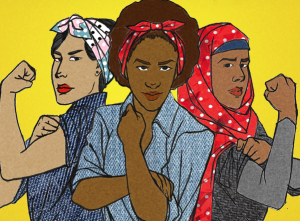
Source: Joonbug Yoga
Originally published on Decolonizing Yoga and republished here with the author’s permission.
As an Indian woman living in the US, I’ve often felt uncomfortable in many yoga spaces.
At times – such as when I take a $25 yoga class by a well-known teacher who wants to “expose us to the culture by chanting Om to start class,” and her studio hangs the Om symbol in the wrong direction – my culture is being stripped of its meaning and sold back to me in forms that feel humiliating at best and dehumanizing at worst.
It took me going to India to really connect with the roots I was seeking on the mat in yoga studios. As I walked the streets of Shimla’s legendary markets, I learned that Indians had been forbidden to tread the main thoroughfares.
It was here that I started to apprehend the true meaning of colonization. Yoga and Ayurveda were legally and de facto banned in India under British rule and colonization.
The practices millions of Westerners now turn to for alternative health and wellness therapies were intentionally eradicated from parts of India to the point that lineages were broken and thousand-year-old traditions lost.
To be colonized is to become a stranger in your own land. As a desi, this is the feeling I get in most Westernized yoga spaces today.
Of course, powerful practices that reduce suffering persist, despite all attempts to end them. These facts are critical to understanding the power and privilege we continue to possess or lack, to clarifying the positionalities we embody as we practice, teach and share yoga today.
Now, when so much of what the Western world sees as true yoga is beautifully achieved physical postures (accomplished, photographed, and displayed by popular yoga magazines, journals, and sites) executed by mostly young, white, stylish-yoga-apparel-clad women and men, yoga is going through a second colonization.
This colonization is the misrepresentation of yoga’s intention, its many limbs, and its aims.
Yoga is not now, nor has it ever been, a practice aimed at physical mastery for its own sake. Nor is it a practice aimed at “stress reduction” so we can function as better producers and consumers in a capitalist society.
Yoga was originally intended to prepare the body as a foundation for unity with the spirit.
The limb of asana aims at strengthening the body. Asana, along with dhyana or meditation, aim to harmonize body with breath in order to attain deeper and deeper states of meditative awareness or samadhi.
The purpose of this kind of meditative awareness is to experience, practice, and live oneness of mind, body, and soul with the divine. This kind of freedom is called samadhi or liberation. It is ironic that practice meant to free us has becoming so confining.
The current state of yoga in the United States and elsewhere in the Western world highlights the power imbalance that remains between those who have access to wealth, an audience, and privilege in contrast to those who have been historically marginalized.
If someone from the dominant culture completes a yoga teacher training that is primarily asana based, and remains blissfully unaware of the complexity of yoga’s true aim or the roots of the practices, they are culturally appropriating yoga.
By remaining unaware of the history, roots, complexity, and challenges of the heritage from which yoga springs and the challenges it has faced under Western culture, they perpetuate a re-colonization of it by stripping its essence away.
Now, this is not to say that there can’t be some true, heartfelt, and deep liberation possible. Or that only Indians can practice or teach yoga and white people can’t. There can be authentic cultural exchange, harmony, and understanding.
Clearly, since the true aim of the practice of yoga is liberation, uniting mind, body, and spirit, this form should not limit us. Liberation here is no joke.
Yoga means liberation from every construct, including that of race, gender, time, space, location, identity, and even history herself.
However, in the current cultural context where there is a billion-dollar industry profiting off of taking yoga out of context, branding, and repackaging it for monetary gain, we need to address this.
Or else we perpetuate a second colonization – eventually eradicating the true practice, as was accomplished in many places under Britain’s occupation of India, and we stray further on the path of maya, or illusion.
These are a few ways to decolonize your yoga practice:
1. Inquire Within
One powerful way we can decolonize yoga and reunite it with its true aim and purpose is to practice Gandhian svadhyaya, or self-rule and inquiry, and to truly learn the full honest, integrity of an authentic yoga practice.
2. Explore, Learn, and Cite Correct Cultural References
As practitioners of yoga, I would love to see more of us citing cultural references as we attempt to understand and connect with the complexity, culture, and history from which this tradition comes.
I’m not suggesting people put on a watered down, context-removed faux Hinduism. To me, that is not the answer.
Commitment to deep practice, questioning, and learning is, perhaps, part of the answer.
3. Ask Ourselves (And Other Yoga Teachers) the Hard Questions
These tensions ask us to bring all of ourselves to the table. So what I am suggesting is that for us to decolonize yoga, we need to inquire deeply.
We each have our unique story and gifts to share, as do all the practitioners we teach or learn from.
Let’s ask ourselves, “For whom is yoga accessible today, and how might that be a legacy of past injustices that we have the opportunity to address through our teaching practice and our lives?”
4. Live, Know, Share, and Practice All Eight Limbs of Yoga – Not Just Asana
We can also decolonize yoga by studying the depth of practice beyond the postures.
In addition to asana, we need to understand, practice, and teach all eight limbs of yoga: yama or ethical conduct; niyama or personal practice; pranayama or working with the breath; pratyahara, awareness of the senses; dharana – meditation, concentration, and insight; dhyana or being present with whatever arises; and samadhi, or interconnection with all that is.
5. Be Humble and Honor Your Own and Other People’s Journeys
When we humbly and respectfully consider yoga’s history, context, many branches, and practices, we give ourselves a fighting chance achieving yoga’s aim of enlightenment of mind, body, and spirit.
By really engaging the full, whole, and multifaceted face of yoga, we not only liberate ourselves, but we may just overthrow this second colonization of yoga, freeing ourselves (as well as the yoga practitioners of the future) to experience the full, liberatory, authentic, and true practice of yoga.
We allow our own practice to grow and our gifts to really shine.
With mutual understanding, respect, and a deep reverence and caring for the history, we can decolonize ourselves, the yoga-industrial complex, and stage our own ahimsa, or nonviolent revolution of the mind, body, and spirit.
***
To learn more about this topic, check out:
- 4 Thoughts for Your Yoga Teacher Who Thinks Appropriation Is Fun
- What’s Wrong with Cultural Appropriation? These 9 Answers Reveal Its Harm
- The Difference Between Cultural Exchange and Cultural Appropriation
[do_widget id=”text-101″]
Susanna Barkataki often cries on her yoga mat out of joy. When she isn’t leading yoga teacher trainings or writing about the power of yoga, Ayurveda, and goddess magic she can be found playing with her son or hiking in the San Gabriel Mountains north of LA. Get more Yoga and Ayurveda right to your inbox at www.healthyhotgoddess.com. You can check her out on Twitter @SusannaWellness.
Search our 3000+ articles!
Read our articles about:
Our online racial justice training
Used by hundreds of universities, non-profits, and businesses.
Click to learn more




















